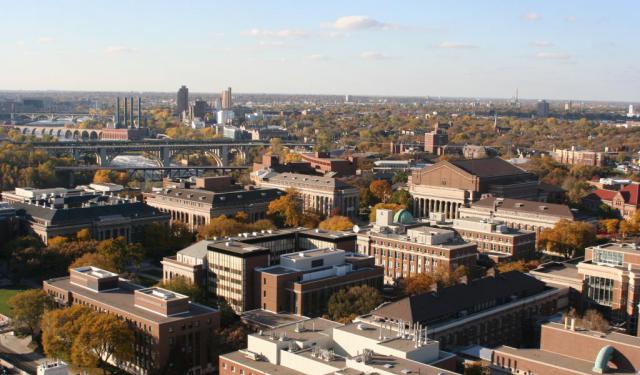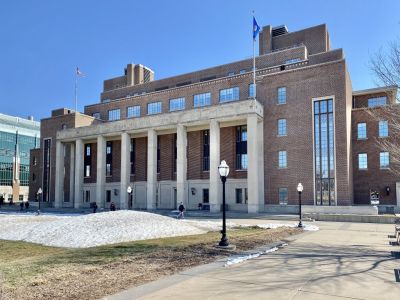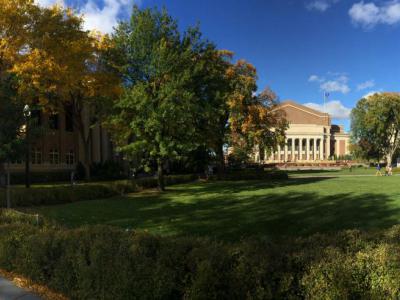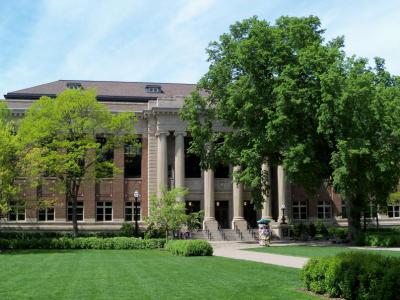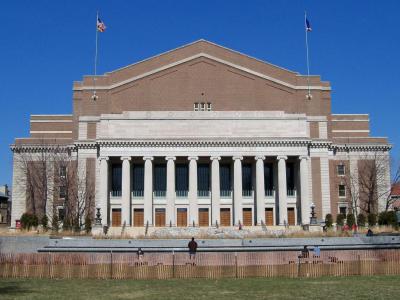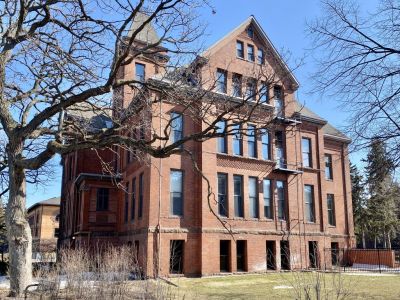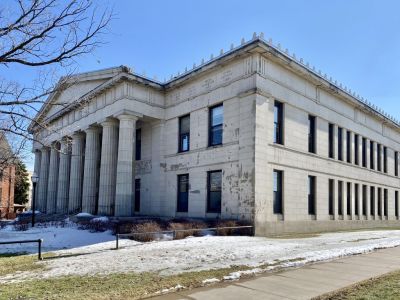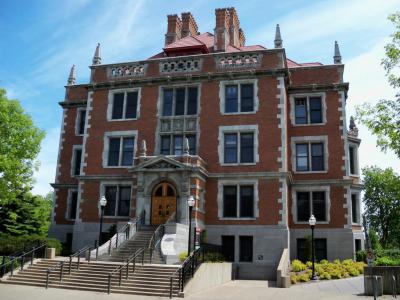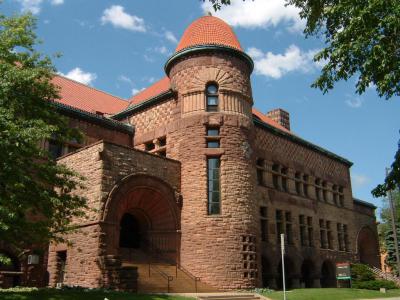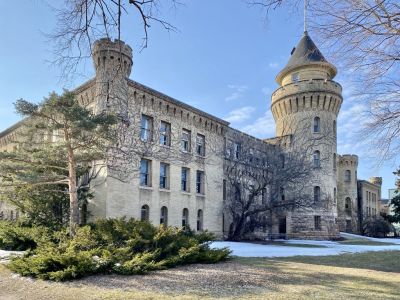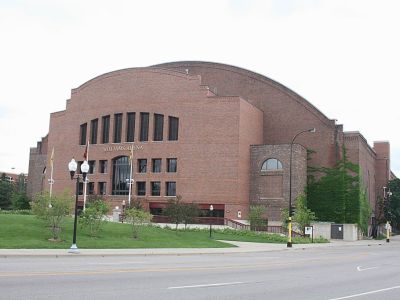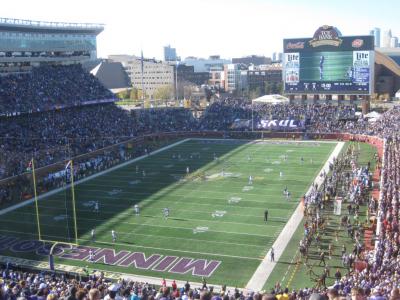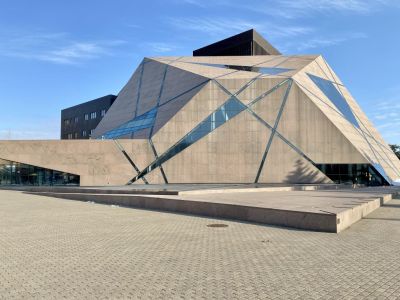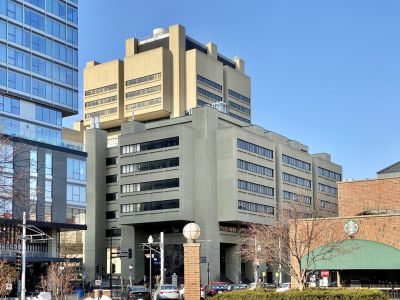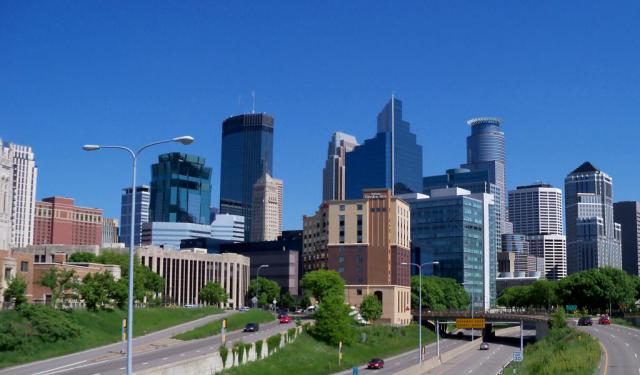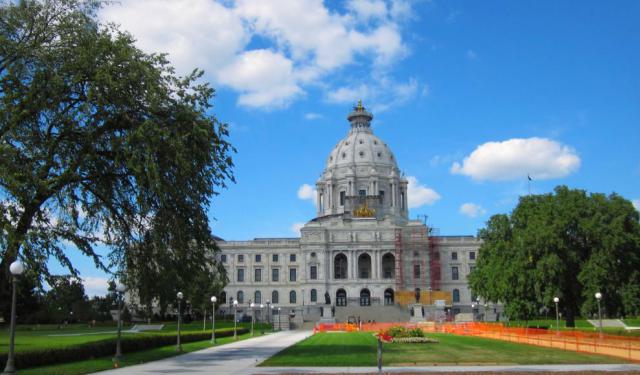University of Minnesota - Minneapolis Campus Walking Tour (Self Guided), Minneapolis
Founded in 1851, seven years before Minnesota became a state, the University of Minnesota is one of the largest educational institutions in the United States. The university campus in the “Twin Cities” of Minneapolis and Saint Paul, spread along the bank of the Mississippi River, is a sprawling hub renowned for its rich academic environment and vibrant life.
One of the central gathering places on campus is Coffman Memorial Union, where students can study, socialize, and grab a bite to eat. The nearby Northrop Mall is a picturesque green space that hosts various events and activities throughout the year.
For students seeking a quiet place to study, Walter Library is a go-to spot with its extensive collection of books and resources. Northrop Auditorium, on the other hand, is a renowned venue for cultural performances and events, adding to the campus's cultural diversity.
Eddy Hall, Burton Hall, and Folwell Hall are academic buildings where students attend classes and engage in academic pursuits. In turn, Pillsbury Hall is known for its historic architecture and houses various departments.
Sports enthusiasts can find their home at the University of Minnesota Armory, Williams Arena, and TCF Bank Stadium, where they can cheer on their favorite Golden Gopher teams. Meanwhile, the McNamara Alumni Center serves as a hub for alumni events and gatherings, connecting past and present students.
The Malcolm Moos Health Sciences Tower is a hub for health-related programs and research, contributing to advancements in healthcare and medical fields.
The diverse range of facilities and opportunities available at the University of Minnesota-Minneapolis provide an enriching college experience. Our self-guided walk offers you a chance to explore its vibrant and dynamic campus community that fosters growth and learning. This educational journey promises to be exciting!
One of the central gathering places on campus is Coffman Memorial Union, where students can study, socialize, and grab a bite to eat. The nearby Northrop Mall is a picturesque green space that hosts various events and activities throughout the year.
For students seeking a quiet place to study, Walter Library is a go-to spot with its extensive collection of books and resources. Northrop Auditorium, on the other hand, is a renowned venue for cultural performances and events, adding to the campus's cultural diversity.
Eddy Hall, Burton Hall, and Folwell Hall are academic buildings where students attend classes and engage in academic pursuits. In turn, Pillsbury Hall is known for its historic architecture and houses various departments.
Sports enthusiasts can find their home at the University of Minnesota Armory, Williams Arena, and TCF Bank Stadium, where they can cheer on their favorite Golden Gopher teams. Meanwhile, the McNamara Alumni Center serves as a hub for alumni events and gatherings, connecting past and present students.
The Malcolm Moos Health Sciences Tower is a hub for health-related programs and research, contributing to advancements in healthcare and medical fields.
The diverse range of facilities and opportunities available at the University of Minnesota-Minneapolis provide an enriching college experience. Our self-guided walk offers you a chance to explore its vibrant and dynamic campus community that fosters growth and learning. This educational journey promises to be exciting!
How it works: Download the app "GPSmyCity: Walks in 1K+ Cities" from Apple App Store or Google Play Store to your mobile phone or tablet. The app turns your mobile device into a personal tour guide and its built-in GPS navigation functions guide you from one tour stop to next. The app works offline, so no data plan is needed when traveling abroad.
University of Minnesota - Minneapolis Campus Walking Tour Map
Guide Name: University of Minnesota - Minneapolis Campus Walking Tour
Guide Location: USA » Minneapolis (See other walking tours in Minneapolis)
Guide Type: Self-guided Walking Tour (Sightseeing)
# of Attractions: 13
Tour Duration: 2 Hour(s)
Travel Distance: 2.9 Km or 1.8 Miles
Author: ChristineS
Sight(s) Featured in This Guide:
Guide Location: USA » Minneapolis (See other walking tours in Minneapolis)
Guide Type: Self-guided Walking Tour (Sightseeing)
# of Attractions: 13
Tour Duration: 2 Hour(s)
Travel Distance: 2.9 Km or 1.8 Miles
Author: ChristineS
Sight(s) Featured in This Guide:
- Coffman Memorial Union
- Northrop Mall
- Walter Library (Digital Technology Center)
- Northrop Auditorium
- Eddy Hall
- Burton Hall
- Folwell Hall
- Pillsbury Hall
- University of Minnesota Armory
- Williams Arena
- Huntington Bank Stadium
- McNamara Alumni Center
- Malcolm Moos Health Sciences Tower
1) Coffman Memorial Union
Coffman Memorial Union is the Twin Cities community’s go-to hub for student buzz, offering concerts, club gatherings, movie nights, a food court, a bookstore, and plenty of study nooks. It’s been a centerpiece of the University of Minnesota since 1939, originally lauded for its sleek Steamship Modern style. While a 1970s renovation swept away much of that original charm, the building’s latest makeover aimed to bring back its 1939 flair while still catering to today’s students.
This revamped Coffman now ticks all the boxes-academic services, retail options, entertainment spaces, and a fresh spin on social hangouts. On top of that, it’s designed to create a seamless corridor connecting the historic Northrop Mall’s central greenspace to the scenic Mississippi River. In short, Coffman is back at full steam, blending its elegant past with a student-centered future.
This revamped Coffman now ticks all the boxes-academic services, retail options, entertainment spaces, and a fresh spin on social hangouts. On top of that, it’s designed to create a seamless corridor connecting the historic Northrop Mall’s central greenspace to the scenic Mississippi River. In short, Coffman is back at full steam, blending its elegant past with a student-centered future.
2) Northrop Mall
Nestled in the heart of the University of Minnesota’s campus, Northrop Mall is a masterclass in grand, Beaux-Arts-style campus planning. This sweeping, orderly green space reflects the “City Beautiful” movement-a period when university campuses were getting serious about looking good while growing bigger.
The story begins with architect Cass Gilbert, who skyrocketed to fame with his design for the Minnesota State Capitol. In 1908, Gilbert’s vision won out in a campus master plan competition. His design, inspired by Beaux-Arts principles, aimed to corral the growing number of academic departments and their corresponding buildings into a harmonious and stately arrangement. It was a hot trend at the time: the University of California at Berkeley had kicked things off with Beaux-Arts planning in 1899, and other universities were eager to follow suit.
Gilbert’s plan started taking shape in 1910 with the construction of Smith Hall, designed by Saint Paul’s Clarence Johnston Sr., who would go on to leave his mark on many of the mall’s structures. By 1920, the university brought on local landscape architects Morell and Nichols to make the campus greenery just as grand as the architecture. This partnership lasted until 1951, and the mall’s transformation continued until 1971, when the final building was completed, cementing the historic district’s status.
Today, Northrop Mall is the academic and social hub of campus life. It’s framed by some of the university’s most iconic buildings: Northrop (formerly Northrop Auditorium) to the north, Coffman Memorial Union to the south, and the formidable trio of Vincent Hall, Tate Laboratory, and Smith Hall lining the sides. Walter Library rounds out the picture with a stately presence. This prime piece of real estate also houses the College of Liberal Arts-Minnesota’s largest college-and the College of Science and Engineering, making Northrop Mall both an intellectual and architectural powerhouse.
The story begins with architect Cass Gilbert, who skyrocketed to fame with his design for the Minnesota State Capitol. In 1908, Gilbert’s vision won out in a campus master plan competition. His design, inspired by Beaux-Arts principles, aimed to corral the growing number of academic departments and their corresponding buildings into a harmonious and stately arrangement. It was a hot trend at the time: the University of California at Berkeley had kicked things off with Beaux-Arts planning in 1899, and other universities were eager to follow suit.
Gilbert’s plan started taking shape in 1910 with the construction of Smith Hall, designed by Saint Paul’s Clarence Johnston Sr., who would go on to leave his mark on many of the mall’s structures. By 1920, the university brought on local landscape architects Morell and Nichols to make the campus greenery just as grand as the architecture. This partnership lasted until 1951, and the mall’s transformation continued until 1971, when the final building was completed, cementing the historic district’s status.
Today, Northrop Mall is the academic and social hub of campus life. It’s framed by some of the university’s most iconic buildings: Northrop (formerly Northrop Auditorium) to the north, Coffman Memorial Union to the south, and the formidable trio of Vincent Hall, Tate Laboratory, and Smith Hall lining the sides. Walter Library rounds out the picture with a stately presence. This prime piece of real estate also houses the College of Liberal Arts-Minnesota’s largest college-and the College of Science and Engineering, making Northrop Mall both an intellectual and architectural powerhouse.
3) Walter Library (Digital Technology Center)
The newly-restored 1924 Walter Library at the University of Minnesota now hosts cutting-edge digital technology, blending the charm of a bygone era with modern innovation. This reinvention required over two years of effort and a hefty $63.4 million investment. Renowned restoration experts Conrad Schmitt Studios teamed up with architects Drew Bjorklund and Bill Beyer of Stageberg Beyer Sachs, Inc. to bring new life to the historic landmark. Their work included restoring the intricate plaster and decorative painting in the public areas and updating the building’s barrel-vaulted lighting to meet today’s safety standards, all without losing a bit of its classic grandeur.
Designed in the grand Beaux-Arts tradition by Minnesota State Architect Clarence H. Johnston Sr., Walter Library shares Northrop Mall’s stately aesthetic, featuring a red brick façade trimmed with Bedford limestone and a majestic Ionic colonnaded portico. Inside, a recurring motif of the owl-symbolizing wisdom and knowledge-is woven into the building’s decor. In fact, there are a whopping 225 owl engravings throughout the library, and a cozy basement eatery is aptly named the Wise Owl Café.
Designed in the grand Beaux-Arts tradition by Minnesota State Architect Clarence H. Johnston Sr., Walter Library shares Northrop Mall’s stately aesthetic, featuring a red brick façade trimmed with Bedford limestone and a majestic Ionic colonnaded portico. Inside, a recurring motif of the owl-symbolizing wisdom and knowledge-is woven into the building’s decor. In fact, there are a whopping 225 owl engravings throughout the library, and a cozy basement eatery is aptly named the Wise Owl Café.
4) Northrop Auditorium
Northrop Auditorium, a campus cornerstone since 1929, has played host to everything from orchestral concerts and dance performances to fiery speeches and rock shows. But by the time it reached its ninth decade, the massive venue was showing its age-acoustics were lackluster, sightlines were tricky, and backstage areas were more cramped than classy. Even the once-grand plasterwork had started crumbling, and a loading dock in the spotlight was, well, less than ideal.
University leaders decided it was time for a major facelift. The concert hall was downsized to improve sound quality-finally fixing those long-standing acoustic woes-and sightlines were thoughtfully reimagined. Designers modernized the vast auditorium with cutting-edge technologies, transforming it into a space that exceeded expectations. The main 2,700-seat hall now sits amidst sleek new lobbies, concessions, classrooms, and even a dance rehearsal studio. An intimate 168-seat hall for lectures, chamber ensembles, and films added a new layer of versatility.
While Northrop received a 21st-century upgrade, it kept its historic charm intact. The Beaux-Arts details, twinkling chandeliers in Memorial Hall, ceremonial staircases, and the iconic sidewall luminaires remain in place, blending seamlessly with modern features like atrium overlooks, sweeping staircases, and reconditioned proscenium medallions.
Today’s Northrop isn’t just a performance space-it’s a hub of creativity and innovation. From contemporary ballet and global dance to jazz series and summer music festivals, this revamped venue continues to set the stage for a diverse and dynamic lineup.
University leaders decided it was time for a major facelift. The concert hall was downsized to improve sound quality-finally fixing those long-standing acoustic woes-and sightlines were thoughtfully reimagined. Designers modernized the vast auditorium with cutting-edge technologies, transforming it into a space that exceeded expectations. The main 2,700-seat hall now sits amidst sleek new lobbies, concessions, classrooms, and even a dance rehearsal studio. An intimate 168-seat hall for lectures, chamber ensembles, and films added a new layer of versatility.
While Northrop received a 21st-century upgrade, it kept its historic charm intact. The Beaux-Arts details, twinkling chandeliers in Memorial Hall, ceremonial staircases, and the iconic sidewall luminaires remain in place, blending seamlessly with modern features like atrium overlooks, sweeping staircases, and reconditioned proscenium medallions.
Today’s Northrop isn’t just a performance space-it’s a hub of creativity and innovation. From contemporary ballet and global dance to jazz series and summer music festivals, this revamped venue continues to set the stage for a diverse and dynamic lineup.
5) Eddy Hall
Eddy Hall, built in 1886, holds the title of the University of Minnesota Twin Cities campus’s eldest surviving structure. Back when the university was experiencing its first major growth spurt, architect Leroy S. Buffington brought the Queen Anne style to life here, using red brick, red sandstone trim, a raised basement, a gabled roof, and a square tower. At a modest $30,000 price tag for construction (plus a $10,000 southern expansion in 1903), Eddy Hall emerged as a symbol of the campus’s ambitions.
Originally known as the Mechanic Arts Building, the structure once buzzed with the university’s mathematics and engineering departments, as well as a handful of labs. That all changed in 1911 when the building was renamed to honor Professor Henry Turner Eddy, a mathematical and engineering luminary who also served as Dean of the Graduate School. Over subsequent years, it has played host to an eclectic cast of occupants: the School of Business, the Department of Spanish and Portuguese Studies, and various administrative offices, to name a few. For nearly four decades, from 1936 to 1974, it even served as headquarters for the university’s radio station, KUOM.
Time has not been kind to Eddy Hall. By 2011, the once-proud building was showing its age, prompting discussions of a multi-million dollar overhaul. However, the funding never materialized, and the proposed renovations remain in limbo. Empty and awaiting a new chapter, Eddy Hall still stands as a campus icon. Fortunately, there’s a glimmer of hope: a major infrastructure upgrade in the Knoll area kicked off in 2019, potentially setting the stage for Eddy Hall’s long-awaited preservation.
Originally known as the Mechanic Arts Building, the structure once buzzed with the university’s mathematics and engineering departments, as well as a handful of labs. That all changed in 1911 when the building was renamed to honor Professor Henry Turner Eddy, a mathematical and engineering luminary who also served as Dean of the Graduate School. Over subsequent years, it has played host to an eclectic cast of occupants: the School of Business, the Department of Spanish and Portuguese Studies, and various administrative offices, to name a few. For nearly four decades, from 1936 to 1974, it even served as headquarters for the university’s radio station, KUOM.
Time has not been kind to Eddy Hall. By 2011, the once-proud building was showing its age, prompting discussions of a multi-million dollar overhaul. However, the funding never materialized, and the proposed renovations remain in limbo. Empty and awaiting a new chapter, Eddy Hall still stands as a campus icon. Fortunately, there’s a glimmer of hope: a major infrastructure upgrade in the Knoll area kicked off in 2019, potentially setting the stage for Eddy Hall’s long-awaited preservation.
6) Burton Hall
Burton Hall, originally known as the Library Building, holds a distinguished spot in the U of M campus. Completed in 1894, it was the first structure built specifically to house the University’s library collection-an improvement over the previous arrangement in Old Main, a building that seemed to have a penchant for catching fire (and ultimately burned to the ground in 1904). Designed with a dual aesthetic, the building’s stately Neo-Classical exterior came from Leroy Buffington, while the Victorian interior was crafted by Charles Sedgwick. Over time, the interior has evolved, but the grand exterior remains a timeless monument.
Buffington envisioned the Library Building as a Greek temple reincarnated, clad in light gray Ohio sandstone. However, his choice of material sparked a local skirmish: Minnesota stonecutters weren’t thrilled about importing stone and argued that a prominent public building should feature local craftsmanship. A compromise was struck: Ohio sandstone it would be, but Minnesotans would cut it onsite. The resulting structure, with its carved classical figures and grand staircase, cost a then-hefty $175,000, making it one of the priciest campus constructions of its day.
More than just a repository for books, the fireproof Library Building became the University’s intellectual and cultural heart. It housed a large reading room, an expansive assembly hall seating up to 800, and even the University chapel. Beyond storing the collection, the building hosted humanities departments and administrative offices, cementing its status as a vibrant campus hub.
The Library Building served as the main library until 1924, when Walter Library took over the role on Northrop Mall. In 1931, the building was rechristened Burton Hall, in honor of Marion Burton, University president from 1917 to 1920. Since 1952, it has been home to the College of Education and Human Development, and while its interior has been thoroughly modernized, its Neo-Classical exterior has remained virtually untouched, standing as one of the few examples of that architectural style on campus.
Buffington envisioned the Library Building as a Greek temple reincarnated, clad in light gray Ohio sandstone. However, his choice of material sparked a local skirmish: Minnesota stonecutters weren’t thrilled about importing stone and argued that a prominent public building should feature local craftsmanship. A compromise was struck: Ohio sandstone it would be, but Minnesotans would cut it onsite. The resulting structure, with its carved classical figures and grand staircase, cost a then-hefty $175,000, making it one of the priciest campus constructions of its day.
More than just a repository for books, the fireproof Library Building became the University’s intellectual and cultural heart. It housed a large reading room, an expansive assembly hall seating up to 800, and even the University chapel. Beyond storing the collection, the building hosted humanities departments and administrative offices, cementing its status as a vibrant campus hub.
The Library Building served as the main library until 1924, when Walter Library took over the role on Northrop Mall. In 1931, the building was rechristened Burton Hall, in honor of Marion Burton, University president from 1917 to 1920. Since 1952, it has been home to the College of Education and Human Development, and while its interior has been thoroughly modernized, its Neo-Classical exterior has remained virtually untouched, standing as one of the few examples of that architectural style on campus.
7) Folwell Hall
A fixture of the National Register of Historic Places, Folwell Hall showcases Jacobethan architecture inspired by the English Renaissance Revival style. Built in 1907, it was crafted by celebrated architect Clarence H. Johnston, Sr., who also left his mark on other iconic Minnesota landmarks, including Northrop Auditorium, Walter Library, and the original Minnesota State Fair Grandstand.
The exterior of Folwell Hall is a visual feast, blending Jacobean and Elizabethan design elements in a parade of gargoyles, sculpted faces, and whimsical animals perched among the 28 ornate chimneys. Tudor arches, steep roof gables, and lighter stone accents around the windows and doors complete the Renaissance Revival charm.
But while the outside received a makeover that restored its historic glory, Folwell’s 127,700-square-foot interior was crying out for help. Narrow stairwells couldn’t accommodate emergency stretchers, cramped offices felt more like broom closets, and the outdated HVAC system left more than 12,000 students sweating or shivering in the 30 classrooms.
Fortunately, by 2011, the Hall underwent a top-to-bottom makeover. Energy-efficient windows replaced the ancient ones, and the HVAC upgrade banished over 50 clunky window air conditioners to history. Inside, classrooms were outfitted with digital tech, the building layout was improved for better flow, and three new elevators and two wider stairwells made the space far more accessible. The sprinkler and fire alarm systems got a modern update, while classic features-like marble and terrazzo floors, original doors, and ornate woodwork-were carefully preserved. The result? A building that nods to its historic roots while embracing modern comforts.
The exterior of Folwell Hall is a visual feast, blending Jacobean and Elizabethan design elements in a parade of gargoyles, sculpted faces, and whimsical animals perched among the 28 ornate chimneys. Tudor arches, steep roof gables, and lighter stone accents around the windows and doors complete the Renaissance Revival charm.
But while the outside received a makeover that restored its historic glory, Folwell’s 127,700-square-foot interior was crying out for help. Narrow stairwells couldn’t accommodate emergency stretchers, cramped offices felt more like broom closets, and the outdated HVAC system left more than 12,000 students sweating or shivering in the 30 classrooms.
Fortunately, by 2011, the Hall underwent a top-to-bottom makeover. Energy-efficient windows replaced the ancient ones, and the HVAC upgrade banished over 50 clunky window air conditioners to history. Inside, classrooms were outfitted with digital tech, the building layout was improved for better flow, and three new elevators and two wider stairwells made the space far more accessible. The sprinkler and fire alarm systems got a modern update, while classic features-like marble and terrazzo floors, original doors, and ornate woodwork-were carefully preserved. The result? A building that nods to its historic roots while embracing modern comforts.
8) Pillsbury Hall
Originally called Science Hall, this building was renamed in honor of Governor John S. Pillsbury while still under construction. Architect Harvey Ellis brought a touch of Richardsonian Romanesque flair to the design, drawing inspiration from Henry Hobson Richardson’s iconic style. However, Ellis didn’t stop there-the building also weaves together elements from the Prairie School, Arts and Crafts, Gothic, and Victorian movements, making it a delightful mash-up of architectural traditions.
After years of standing as an iconic yet outdated fixture, Pillsbury Hall recently underwent a renovation that breathed new life into the structure, turning it into a vibrant hub for the humanities. The design carefully preserved the building’s history while modernizing it for energy efficiency, accessibility, and flexible educational use. Unorthodox historic details were embraced rather than erased. Case in point: the building’s signature turret now houses a staircase that connects all four floors for the first time. Interior walls were stripped back to reveal the original masonry, blending the old with the new in one cohesive experience.
One of the most striking upgrades took place in the attic, which was once a dusty storage area. Now, it’s a grand recital hall and reception space. Its tiered timber trusses rise high above, creating an inspiring venue for classes, poetry readings, and special events-proof that even the most neglected corners can become show-stopping highlights.
On the first floor, the Liberal Arts Engagement Hub offers a fresh twist on traditional academic spaces. Located just a few miles from George Floyd Square, the Hub serves as a bridge between the University and the wider community. Here, students, faculty, and community members collaborate on critical topics, drawing on the work of Humanities for All to inform debates, amplify voices, preserve culture, and expand educational access..
After years of standing as an iconic yet outdated fixture, Pillsbury Hall recently underwent a renovation that breathed new life into the structure, turning it into a vibrant hub for the humanities. The design carefully preserved the building’s history while modernizing it for energy efficiency, accessibility, and flexible educational use. Unorthodox historic details were embraced rather than erased. Case in point: the building’s signature turret now houses a staircase that connects all four floors for the first time. Interior walls were stripped back to reveal the original masonry, blending the old with the new in one cohesive experience.
One of the most striking upgrades took place in the attic, which was once a dusty storage area. Now, it’s a grand recital hall and reception space. Its tiered timber trusses rise high above, creating an inspiring venue for classes, poetry readings, and special events-proof that even the most neglected corners can become show-stopping highlights.
On the first floor, the Liberal Arts Engagement Hub offers a fresh twist on traditional academic spaces. Located just a few miles from George Floyd Square, the Hub serves as a bridge between the University and the wider community. Here, students, faculty, and community members collaborate on critical topics, drawing on the work of Humanities for All to inform debates, amplify voices, preserve culture, and expand educational access..
9) University of Minnesota Armory
The University of Minnesota opened its doors in 1869, aided by federal subsidies and adhering to the Land Grant Act of 1862’s mandate for military instruction. From 1884 onward, the facilities for teaching military tactics also pulled double duty for other University needs. After a fire destroyed the Coliseum auditorium and drill hall, architecture professor Charles Aldrich gave the building a fortress-like appearance, designing it to handle not just military drills, but also athletic training and a variety of University events. When it opened in 1896, it was the largest building on campus.
The Armory featured a ramp and sally port entrance that led into a spacious two-story assembly and drill hall. With suspended galleries and adjustable partitions, the space could transform to suit its audience: as an auditorium, it seated 3,700; as a ballroom, it offered room for over 300 couples to dance the night away. Even after Northrop Auditorium was completed in 1929, the Armory remained a go-to venue for military ceremonies, final exams, and all sorts of campus happenings.
Today, the building serves as the headquarters for the University’s three ROTC units, as well as offices for the University’s high school programs. The gymnasium still gets a workout, hosting various campus events.
Tip: Just outside the Armory, you will find a nine-foot-tall statue known as “Iron Mike,” standing on a six-foot-high Vermont granite pedestal that tips the scales at seven tons. This striking figure honors the University’s students who served in the Spanish-American War. The statue was the brainchild of a committee originally formed to send Christmas gifts to student soldiers stationed in Manila. Committee chair Professor Arthur E. Haynes suggested a more lasting tribute, donated the first ten dollars, and spearheaded the fundraising and design effort. The statue was unveiled in 1906 and continues to stand as a reminder of the University’s past.
The Armory featured a ramp and sally port entrance that led into a spacious two-story assembly and drill hall. With suspended galleries and adjustable partitions, the space could transform to suit its audience: as an auditorium, it seated 3,700; as a ballroom, it offered room for over 300 couples to dance the night away. Even after Northrop Auditorium was completed in 1929, the Armory remained a go-to venue for military ceremonies, final exams, and all sorts of campus happenings.
Today, the building serves as the headquarters for the University’s three ROTC units, as well as offices for the University’s high school programs. The gymnasium still gets a workout, hosting various campus events.
Tip: Just outside the Armory, you will find a nine-foot-tall statue known as “Iron Mike,” standing on a six-foot-high Vermont granite pedestal that tips the scales at seven tons. This striking figure honors the University’s students who served in the Spanish-American War. The statue was the brainchild of a committee originally formed to send Christmas gifts to student soldiers stationed in Manila. Committee chair Professor Arthur E. Haynes suggested a more lasting tribute, donated the first ten dollars, and spearheaded the fundraising and design effort. The statue was unveiled in 1906 and continues to stand as a reminder of the University’s past.
10) Williams Arena
No basketball pilgrimage in Minneapolis is complete without paying homage to “The Barn.” Rich with history and tradition, the University of Minnesota’s Williams Arena has been standing tall since 1928, making it one of the country’s oldest athletic venues. Its most iconic feature? A raised court perched two feet above the benches and scorer’s table. Today, it’s the home turf for the Golden Gopher men’s and women’s basketball teams, but its story stretches well beyond hoops.
In its early years, The Barn was a multi-sport marvel. After basketball season, the floor was cleared out to make way for tennis courts and an indoor track. A 1950 overhaul gave the arena a split personality: hockey rink on one end, basketball court on the other. With 18,025 seats, it was the largest collegiate basketball arena in the country until 1971. Renovations, fire-code updates, and accessibility improvements have since brought the capacity down to 14,625. When Mariucci Arena opened across the street in 1993, the old hockey rink at Williams transformed into the Maturi Sports Pavilion.
Over the decades, Williams Arena has seen some of the game’s greatest players leave their mark-legends like Kevin McHale and Amir Coffey on the men’s side, and Linda Roberts or Lindsay Whalen on the women’s. Few gyms can match The Barn’s aura. When the Gopher faithful fill the stands, the mystique of this historic venue delivers a home-court advantage that’s hard to beat.
In its early years, The Barn was a multi-sport marvel. After basketball season, the floor was cleared out to make way for tennis courts and an indoor track. A 1950 overhaul gave the arena a split personality: hockey rink on one end, basketball court on the other. With 18,025 seats, it was the largest collegiate basketball arena in the country until 1971. Renovations, fire-code updates, and accessibility improvements have since brought the capacity down to 14,625. When Mariucci Arena opened across the street in 1993, the old hockey rink at Williams transformed into the Maturi Sports Pavilion.
Over the decades, Williams Arena has seen some of the game’s greatest players leave their mark-legends like Kevin McHale and Amir Coffey on the men’s side, and Linda Roberts or Lindsay Whalen on the women’s. Few gyms can match The Barn’s aura. When the Gopher faithful fill the stands, the mystique of this historic venue delivers a home-court advantage that’s hard to beat.
11) Huntington Bank Stadium
There’s no better way to spend a crisp fall Saturday in Minneapolis than cheering on the Golden Gophers at Huntington Bank Stadium. Opened in 2009, this 50,805-seat gem is the Big Ten’s freshest stadium since 1960, offering top-notch sightlines, modern amenities, and one of the most impressive scoreboards in all of college football.
If you’re heading to a game, make sure to settle into your seat at least 20 minutes before kickoff. Why? So you can catch The Pride of Minnesota-the University’s iconic marching band-storming the field to Sousa’s “Minnesota March.” As the band forms a massive “Block M” and breaks into the cherished Minnesota Rouser, the stadium comes alive. Moments later, the Golden Gophers charge onto the turf, greeted by the thunderous cheers of maroon-and-gold-clad fans.
Of course, the Gopher game-day experience isn’t confined to the stadium. Around campus, a carnival of tailgates springs to life. University Avenue becomes a hive of activity, where students pack fraternity lawns for a tailgate scene as lively as it is eclectic. Meanwhile, nearby parking lots-and even spots on the Saint Paul campus-are filled with Gopher faithful, setting up everything from simple cooler-and-chair arrangements to full-blown catering spreads with multiple TVs showing live games. When it comes to pre-game revelry, Gopher fans are seasoned pros.
And the fun doesn’t stop at football. Right across the street, you can catch Gophers basketball at Williams Arena, volleyball at Maturi Pavilion, or hockey at both 3M Arena at Mariucci and Ridder Arena. Whether you’re in the mood for more sports or looking to explore the University’s rich arts and cultural offerings, there’s always something happening at “the U.”
If you’re heading to a game, make sure to settle into your seat at least 20 minutes before kickoff. Why? So you can catch The Pride of Minnesota-the University’s iconic marching band-storming the field to Sousa’s “Minnesota March.” As the band forms a massive “Block M” and breaks into the cherished Minnesota Rouser, the stadium comes alive. Moments later, the Golden Gophers charge onto the turf, greeted by the thunderous cheers of maroon-and-gold-clad fans.
Of course, the Gopher game-day experience isn’t confined to the stadium. Around campus, a carnival of tailgates springs to life. University Avenue becomes a hive of activity, where students pack fraternity lawns for a tailgate scene as lively as it is eclectic. Meanwhile, nearby parking lots-and even spots on the Saint Paul campus-are filled with Gopher faithful, setting up everything from simple cooler-and-chair arrangements to full-blown catering spreads with multiple TVs showing live games. When it comes to pre-game revelry, Gopher fans are seasoned pros.
And the fun doesn’t stop at football. Right across the street, you can catch Gophers basketball at Williams Arena, volleyball at Maturi Pavilion, or hockey at both 3M Arena at Mariucci and Ridder Arena. Whether you’re in the mood for more sports or looking to explore the University’s rich arts and cultural offerings, there’s always something happening at “the U.”
12) McNamara Alumni Center
The McNamara Alumni Center is one of the University of Minnesota’s most architecturally striking landmarks and a standout in the Twin Cities skyline. Designed by internationally acclaimed architect Antoine Predock, the building draws inspiration from Minnesota’s natural wonders-its 10,000 lakes, the rugged North Shore, the Iron Range, and the Northern Lights-translated into its unique forms, materials, and textures. Key design highlights include a pink granite-covered geode-like exterior with dramatic star-shaped glass fissures, an 85-foot tall Memorial Hall clad in six miles of wood and featuring a tranquil water stream, and 75,000 square feet of gleaming copper sheathing both exterior and interior walls. Construction began in March 1998, and the 231,000-square-foot marvel opened its doors in February 2000.
Since its debut, McNamara has become a bustling epicenter of campus life, home to more than 900 University employees and serving as a premier event destination. Its 40,000+ square feet of event spaces have hosted over 12,000 University gatherings, as well as 2,500 external events and 900 weddings. For countless attendees, McNamara serves as their first impression of the U of M.
Consistently recognized for excellence-earning the title of Best Meeting Venue from Minnesota Meetings & Events magazine for six consecutive years-McNamara offers practical conveniences, including tunnel connections to a nearby 500-car parking ramp and hotel, swift highway access, and award-winning catering by D’Amico Catering.
Pro tip: Just outside the center, you’ll find a sunlit common area perfect for a picnic. Pick up lunch from one of the many nearby restaurants and enjoy the Minnesota sunshine solo or with friends.
Since its debut, McNamara has become a bustling epicenter of campus life, home to more than 900 University employees and serving as a premier event destination. Its 40,000+ square feet of event spaces have hosted over 12,000 University gatherings, as well as 2,500 external events and 900 weddings. For countless attendees, McNamara serves as their first impression of the U of M.
Consistently recognized for excellence-earning the title of Best Meeting Venue from Minnesota Meetings & Events magazine for six consecutive years-McNamara offers practical conveniences, including tunnel connections to a nearby 500-car parking ramp and hotel, swift highway access, and award-winning catering by D’Amico Catering.
Pro tip: Just outside the center, you’ll find a sunlit common area perfect for a picnic. Pick up lunch from one of the many nearby restaurants and enjoy the Minnesota sunshine solo or with friends.
13) Malcolm Moos Health Sciences Tower
Moos Tower: the campus giant that sparks as many opinions as it does glances upward. With 17 floors, a height of 853 feet, and an exposed aggregate concrete façade, it’s the University of Minnesota’s tallest building-and, let’s face it, one of its least visually beloved. Yet behind its stark appearance lies a story rooted in 1970s university politics and architectural trends.
Conceived by The Architects Collaborative of Cambridge, Massachusetts, the building was completed in the early 1970s and named for Malcolm Moos, a political scientist and the University’s president at the time. Moos Tower is a bold example of brutalism, a design movement that embraced unadorned materials and fortress-like forms. Back then, brutalist architecture was all the rage-intended to stand out in the urban landscape and project strength during a time of societal unrest, including the civil rights era and anti-Vietnam War protests. For a campus that had just witnessed major student demonstrations in May 1972, the solid, uncompromising aesthetic of Moos Tower mirrored the tense and uncertain mood of the times.
Brutalism also offered practical benefits. The raw, utilitarian design allowed for flexibility-interior walls can be shifted to adapt to changing healthcare and academic needs. While it may not win any beauty contests, the building functions well as a medical and educational hub, serving its purpose without frills. In that sense, it’s a true product of its era: unyielding, pragmatic, and a little intimidating. Like it or not, it remains a landmark and a piece of architecture that, for better or worse, has stood the test of time.
Conceived by The Architects Collaborative of Cambridge, Massachusetts, the building was completed in the early 1970s and named for Malcolm Moos, a political scientist and the University’s president at the time. Moos Tower is a bold example of brutalism, a design movement that embraced unadorned materials and fortress-like forms. Back then, brutalist architecture was all the rage-intended to stand out in the urban landscape and project strength during a time of societal unrest, including the civil rights era and anti-Vietnam War protests. For a campus that had just witnessed major student demonstrations in May 1972, the solid, uncompromising aesthetic of Moos Tower mirrored the tense and uncertain mood of the times.
Brutalism also offered practical benefits. The raw, utilitarian design allowed for flexibility-interior walls can be shifted to adapt to changing healthcare and academic needs. While it may not win any beauty contests, the building functions well as a medical and educational hub, serving its purpose without frills. In that sense, it’s a true product of its era: unyielding, pragmatic, and a little intimidating. Like it or not, it remains a landmark and a piece of architecture that, for better or worse, has stood the test of time.
Walking Tours in Minneapolis, Minnesota
Create Your Own Walk in Minneapolis
Creating your own self-guided walk in Minneapolis is easy and fun. Choose the city attractions that you want to see and a walk route map will be created just for you. You can even set your hotel as the start point of the walk.
Minneapolis Introduction Walking Tour
Minneapolis is a major city in Minnesota, straddling the Mississippi River. Together with neighboring Saint Paul, the state capital of Minnesota, it forms the metropolitan area collectively known as the "Twin Cities."
Before European settlement, the site of Minneapolis was inhabited by Dakota people. The settlement was founded along Saint Anthony Falls - the only natural waterfall on... view more
Tour Duration: 2 Hour(s)
Travel Distance: 4.2 Km or 2.6 Miles
Before European settlement, the site of Minneapolis was inhabited by Dakota people. The settlement was founded along Saint Anthony Falls - the only natural waterfall on... view more
Tour Duration: 2 Hour(s)
Travel Distance: 4.2 Km or 2.6 Miles
Historical Churches
The "City of Lakes”, Minneapolis, doesn't pride itself solely on the lakes. In fact, you will be amazed by how many churches, cathedrals, and other places of worship are found throughout the city. These sacred structures have played a significant role in the development of Minneapolis and continue to serve as pillars of faith and community. Let's take a look at some of the most... view more
Tour Duration: 1 Hour(s)
Travel Distance: 2.8 Km or 1.7 Miles
Tour Duration: 1 Hour(s)
Travel Distance: 2.8 Km or 1.7 Miles
Saint Paul Introduction Walking Tour
Saint Paul is a fantastic example of a city that has grown through a diverse range of cultures. The location near the Mississippi River helped make what would later become the city a significant center of local trade. The Dakota Sioux tribe were among the earliest residents, and European settlement that included French-Canadian fur traders and Catholic missionaries occurred during the 1830s to... view more
Tour Duration: 2 Hour(s)
Travel Distance: 3.4 Km or 2.1 Miles
Tour Duration: 2 Hour(s)
Travel Distance: 3.4 Km or 2.1 Miles
The Most Popular Cities
/ view all
